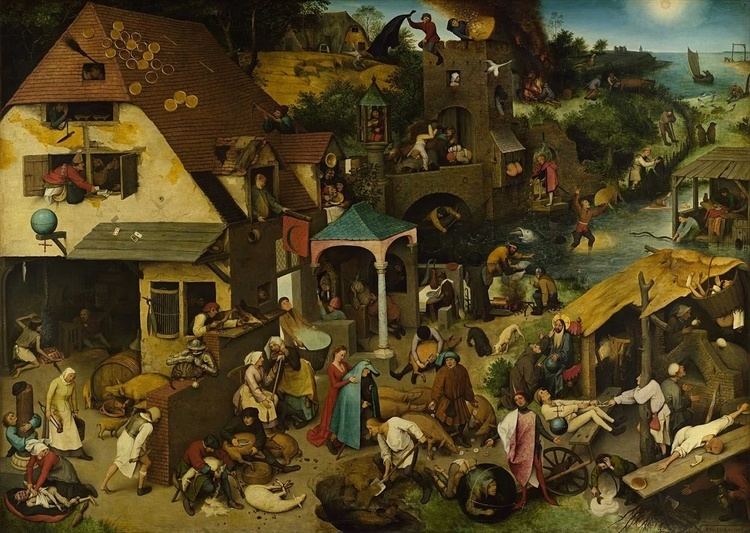Year 1559 | Dimensions 1.17 m x 1.63 m Created 1559 | |
 | ||
Media Paint, Panel painting, Wood, Oil paint Similar Pieter Bruegel the Elder artwork, Panel painting | ||
Bruegel s netherlandish proverbs explained in detail hd
Netherlandish Proverbs (Dutch: Nederlandse Spreekwoorden; also called Flemish Proverbs, The Blue Cloak or The Topsy Turvy World) is a 1559 oil-on-oak-panel painting by the Flemish artist Pieter Bruegel the Elder that depicts a scene in which humans and, to a lesser extent, animals and objects, offer literal illustrations of Dutch language proverbs and idioms.
Contents
- Bruegel s netherlandish proverbs explained in detail hd
- Pieter bruegel the elder netherlandish proverbs flemish proverbs and the blue cloak
- Context
- Proverbs and idioms
- Inspiration for other paintings
- References
Running themes in Bruegel's paintings are the absurdity, wickedness and foolishness of humans, and this is no exception. The painting's original title, The Blue Cloak or The Folly of the World, indicates that Bruegel's intent was not just to illustrate proverbs, but rather to catalog human folly. Many of the people depicted show the characteristic blank features that Bruegel used to portray fools.
His son, Pieter Brueghel the Younger, specialised in making copies of his father's work and painted at least 16 copies of Netherlandish Proverbs. Not all versions of the painting, by father or son, show exactly the same proverbs and they also differ in other minor details.
Pieter bruegel the elder netherlandish proverbs flemish proverbs and the blue cloak
Context
Proverbs were very popular in Bruegel's time and before; a hundred years before Bruegel's painting, illustrations of proverbs had been popular in the Flemish books of hours. A number of collections were published, including Adagia, by the Dutch humanist Desiderius Erasmus. The French writer François Rabelais employed significant numbers in his novel Gargantua and Pantagruel, completed in 1564.
The Flemish artist Frans Hogenberg made an engraving illustrating 43 proverbs in around 1558, roughly the same time as Bruegel's painting. The work is very similar in composition to Bruegel's and includes certain proverbs (like the blue cloak) which also feature prominently in Netherlandish Proverbs. By depicting literal renditions of proverbs in a peasant setting, both artists have shown a "world turned upside down".
Bruegel himself had painted several minor paintings on the subject of proverbs including Big Fish Eat Little Fish (1556) and Twelve Proverbs (1558), but Netherlandish Proverbs is thought to have been his first large-scale painting on the theme.
Proverbs and idioms
Critics have praised the composition for its ordered portrayal and integrated scene. There are approximately 112 identifiable proverbs and idioms in the scene, although Bruegel may have included others which cannot be determined. Some of those incorporated in the painting are still in popular use, for instance "Swimming against the tide", "Banging one's head against a brick wall" and "Armed to the teeth", and there are some that are familiar if not identical to the modern English usage such as "casting roses before swine". Many more have faded from use or have never been used in English. "Having one's roof tiled with tarts", for example, which meant to have an abundance of everything and was an image Bruegel would later feature in his painting of the idyllic Land of Cockaigne (1567).
The Blue Cloak, the piece's original title, features in the centre of the piece and is being placed on a man by his wife, indicating that she is cuckolding him. Other proverbs indicate human foolishness. A man fills in a pond after his calf has died. Just above the central figure of the blue-cloaked man another man carries daylight in a basket. Some of the figures seem to represent more than one figure of speech (whether this was Bruegel's intention or not is unknown), such as the man shearing a sheep in the centre bottom left of the picture. He is sitting next to a man shearing a pig, so represents the expression "One shears sheep and one shears pigs", meaning that one has the advantage over the other, but may also represent the advice "Shear them but don't skin them", meaning make the most of available assets.
Inspiration for other paintings
This painting has inspired others to depict multiple proverbs in their paintings, also. An illustration from the Hong Kong magazine Passion Times illustrates dozens of Cantonese proverbs. The painting Proverbidioms was also inspired by this Dutch painting to depict English proverbs and idioms.
